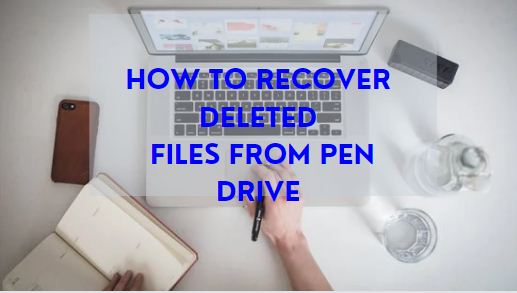Introduction to how to recover deleted files from pen drive:

In the digital age, where data is at the heart of our daily activities, the loss of important files from a pen drive can be a harrowing experience. This article delves into the crucial aspects of recovering deleted files from a pen drive, emphasizing the significance of timely recovery to thwart potential data loss.
Understanding Data Deletion:
Files on a pen drive may vanish for various reasons, making it imperative to comprehend the mechanics behind data deletion. This section elucidates the nuances between logical and physical deletion, shedding light on the intricacies of how files are removed from these portable storage devices.
Precautions Before Recovery:
Before embarking on the recovery journey, it is essential to take precautionary measures. Ceasing any further data write operations and disconnecting the pen drive are crucial steps to prevent overwriting deleted data, ensuring the highest chances of successful recovery.
Software Options for File Recovery:
Navigating the realm of file recovery software can be daunting, but this section introduces reputable options, compares their features, and provides a step-by-step guide on utilizing selected software for effective recovery. Empowering users to make informed choices is key to retrieving lost data.
Manual Recovery Methods:
For those who prefer a hands-on approach, manual recovery methods offer an alternative. This section provides an overview of navigating through system and hidden files, accompanied by a step-by-step guide on using CMD (Command Prompt) for a meticulous recovery process.
A. Overview of Manual Methods for File Recovery:
- Navigating Through System and Hidden Files:
- Understanding File System Structure: Delve into the file system of the pen drive, commonly using FAT32 or NTFS. Recognizing the folder structure and file locations is crucial for manual recovery.
- Exploring Hidden Files: Many files may be hidden by default. Adjusting folder settings to show hidden files enables users to identify and recover data that might not be visible through regular file explorers.
- Explanation of How to Navigate Through System and Hidden Files:
- File Explorer (Windows) or Finder (Mac): Utilize the native file explorer to navigate through the pen drive. Adjust settings to display hidden files for a comprehensive view.
- Command-Line Interface (CMD) for Advanced Users: Experienced users can leverage the command-line interface for a more granular approach. Use commands such as ‘dir’ and ‘attrib’ in CMD to list and manipulate files.
- Step-by-Step Guide on Using CMD (Command Prompt) for Recovery:
- Accessing CMD: Open the Command Prompt with administrative privileges for enhanced control.
- Navigating to the Pen Drive: Use the ‘cd’ command to change the directory to the pen drive. For example, ‘cd E:’ if the pen drive is assigned the ‘E’ drive letter.
- Listing Files: Employ the ‘dir’ command to list files and folders on the pen drive. This helps in identifying the presence of deleted files.
- Recovering Files: If files are identified, execute commands like ‘copy’ or ‘xcopy’ to recover selected files to a new location.
B. Advantages of Manual Recovery Methods:
- No External Software Dependency:
- Manual methods do not rely on third-party software, making them a go-to option for users who prefer to avoid additional installations.
- This approach utilizes built-in tools and commands, reducing the need for external dependencies.
- Granular Control:
- Users have precise control over file selection and recovery. This is particularly advantageous when attempting to recover specific files or folders rather than an entire dataset.
C. Challenges of Manual Recovery Methods:
- Complexity for Non-Technical Users:
- Navigating through system and hidden files via CMD or adjusting folder settings may be challenging for users with limited technical expertise.
- The risk of accidental data modification or deletion is higher, especially for those unfamiliar with command-line operations.
- Time-Consuming Process:
- Manual recovery methods can be time-consuming, particularly when dealing with large volumes of data. Scanning through directories and using command-line operations may require more effort than using automated software.
In conclusion, manual recovery methods provide a viable alternative for users who prefer not to rely on external software. While offering granular control, they require a level of technical proficiency and patience. Users should weigh the advantages and challenges to determine the most suitable approach for recovering deleted files from their pen drives.
Common Challenges and Solutions:
No journey is without obstacles. Addressing common issues encountered during file recovery, this section offers a troubleshooting guide to overcome challenges, ensuring a smoother recovery experience.
Tips for Effective Recovery:
Prevention is often the best cure. This section advocates creating regular backups as a proactive measure against data loss. Additionally, keeping the pen drive in optimal condition and employing antivirus software safeguards against hardware issues and potential malware threats.
Prevention of Future Data Loss:
The article concludes by emphasizing the importance of implementing good file management practices. Encouraging users to use antivirus software as a shield against malware and data corruption, it reinforces the need for proactive measures to ensure the longevity and integrity of their data.
In conclusion, mastering the art of pen drive file recovery requires a holistic approach that combines knowledge, precautionary steps, and the right tools. By understanding the intricacies of data deletion and implementing effective recovery strategies, users can safeguard their valuable files and maintain a proactive stance against potential data loss.
Leave a Reply